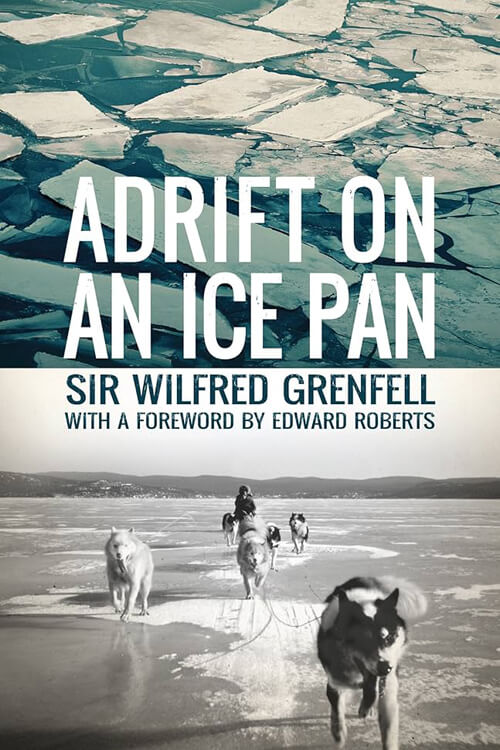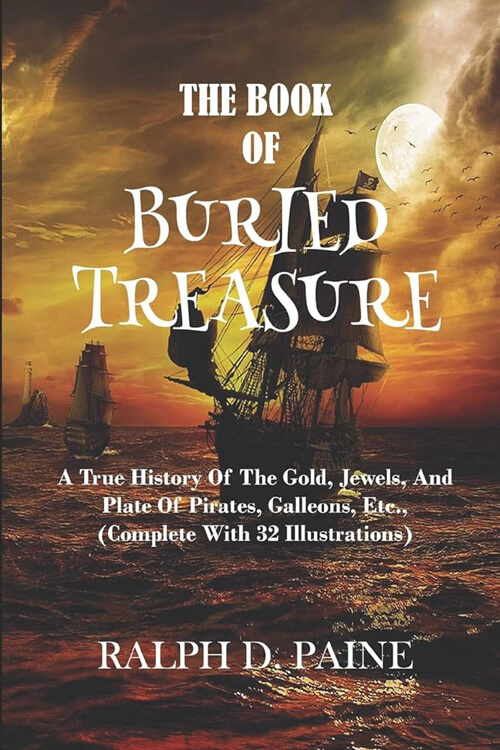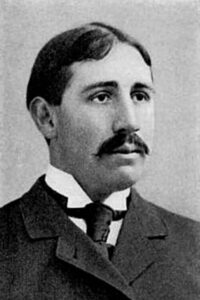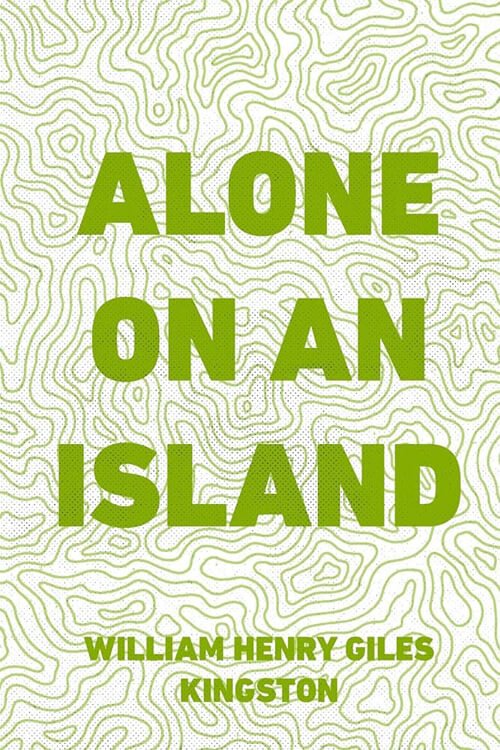
The Book of Buried Treasure
The language has no more boldly romantic words than pirate and galleon and the dullest imagination is apt to be kindled by any plausible dream of finding their lost treasures hidden on a lonely beach or tropic key, or sunk fathoms deep in salt water. In the preface of that rare and exceedingly diverting volume, “The Pirates’ Own Book,” the unnamed author sums up the matter with so much gusto and with so gorgeously appetizing a flavor that he is worth quoting to this extent:
“The name of the pirate is also associated with ideas of rich plunder, caskets of buried jewels, chests of gold ingots, bags of outlandish coins, secreted in lonely, out-of-the-way places, or buried about the wild shores of rivers and unexplored sea coasts, near rocks and trees bearing mysterious marks indicating where the treasure was hidden. And as it is his invariable practice to secrete and bury his booty, and from the perilous life he leads, being often killed or captured, he can never revisit the spot, therefore immense sums remain buried in those places and are irrevocably lost. Search is often made by persons who labor in anticipation of throwing up with their spade and pickaxe, gold bars, diamond crosses sparkling amongst the dirt, bags of golden doubloons and chests wedged close with moidores, ducats, and pearls; but although great treasures lie hid in this way, it seldom happens that any is recovered.”
In this tamed, prosaic age of ours, treasure-seeking might seem to be the peculiar province of fiction, but the fact is that expeditions are fitting out every little while, and mysterious schooners flitting from many ports, lured by grimy, tattered charts presumed to show where the hoards were hidden, or steering their courses by nothing more tangible than legend and surmise. As the Kidd tradition survives along the Atlantic coast, so on divers shores of other seas persist the same kind of wild tales, the more convincing of which are strikingly alike in that the lone survivor of the red-handed crew, having somehow escaped the hanging, shooting, or drowning that he handsomely merited, preserved a chart showing where the treasure had been hid. Unable to return to the place, he gave the parchment to some friend or shipmate, this dramatic transfer usually happened as a death-bed ceremony. The recipient, after digging in vain and heartily damning the departed pirate for his misleading landmarks and bearings, handed the chart down to the next generation.
It will be readily perceived that this is the stock motive of almost all buried treasure fiction, the trademark of a certain brand of adventure story, but it is more entertaining to know that such charts and records exist and are made use of by the expeditions of the present day. Opportunity knocks at the door. He who would gamble in shares of such speculation may find sun-burned, tarry gentlemen, from Seattle to Singapore, and from Capetown to New Zealand, eager to whisper curious information of charts and sailing directions, and to make sail and away.
Some of them are still seeking booty lost on Cocos Island off the coast of Costa Rica where a dozen expeditions have futilely sweated and dug; others have cast anchor in harbors of Guam and the Carolines; while as you run from Aden to Vladivostok, sailormen are never done with spinning yarns of treasure buried by the pirates of the Indian Ocean and the China Sea. Out from Callao, the treasure hunters fare to Clipperton Island, or the Galapagos group where the buccaneers with Dampier and Davis used to careen their ships, and from Valparaiso, many an expedition has found its way to Juan Fernandez and Magellan Straits.
Read or download Book
Ralph Delahaye Paine
Ralph Delahaye Paine (August 28, 1871 – April 29, 1925) was an American journalist and author popular in the early 20th century. Later, he held both elected and appointed government offices.
Life and career
Born in Lemont, Illinois, Paine was the son of Reverend Samuel Delahaye Paine. Rev. Paine was born in London and served in the British Army during the Crimean War before emigrating to America in 1856. Rev. Paine served as a lieutenant in the 2nd Maine Battery during the American Civil War and later was chaplain-in-chief of the Grand Army of the Republic.
While his father was pastor of the Ocean Street Presbyterian Church in Jacksonville, Florida, 115 Paine worked as a reporter for twelve dollars a week. He also frequented a soda fountain in a cigar shop owned by Cuban revolutionary José Alejandro Huau.
Paine attended Hillhouse High School in New Haven, Connecticut, and then Yale University. At Yale, he was on the football and rowing teams and was a member of Skull and Bones. At Yale, he covered athletic news for a news syndicate. This, plus the money he saved reporting in Jacksonville, paid for his education. He graduated in 1894.
After graduating, Paine worked for the Philadelphia Press until 1901. Paine’s connection to Huau came to the attention of newspaperman William Randolph Hearst when American newspapers were publishing frenzied coverage of the Cuban War of Independence. Hearst’s New York Journal had held a contest to determine the “world’s greatest living soldier”, and Cuban revolutionary military commander Máximo Gómez was the winner. The prize was a gold-plated and diamond-encrusted sword inscribed “Viva Cuba Libre” and “To Máximo Gómez, Commander-in-Chief of the Army of the Republic of Cuba”. Hearst needed someone to deliver the sword to Gomez and offered Paine the task. Paine replied, “I am the damn fool you have been looking for.”
Huau got Paine and another reporter, Ernest McCready, on a boat smuggling munitions and soldiers to Cuba, the Three Friends under Captain “Dynamite” Johnny O’Brien. The Three Friends got into a skirmish with a Spanish gunboat and, in the only naval battle of the war, inexplicably triumphed. However, since the US was not participating in the war, O’Brien, fearing legal entanglements and seizure of his vessel, fled and left passengers and cargo on No Name Key. After filing his story in Key West, Paine managed to get on board the Dauntless, which came to retrieve the cargo under the supervision of General Emilio Núñez. He let Paine and McCready on board, but Núñez, annoyed by a delay they had caused, refused to let them off at Corrientes Bay and returned them to Jacksonville. Upon his return, he discovered that he was among those indicted for piracy (a capital crime) in the Three Friends incident. With the assistance of his father, Paine went into hiding for a month. However, one of the co-owners of the boat was a powerful sheriff and future Governor of Florida Napoleon Broward. Thanks to his influence, no witnesses could identify any participants in the affair and the case was dropped. Paine gave the sword to José Huau, who had it delivered to Gómez’s wife in Santo Domingo and returned to his job at the Philadelphia Press.
The Spanish–American War soon broke out, and Paine was aboard the USS New York, the flagship of Admiral William T. Sampson, when it bombed Matanzas. Paine was also among a group of reporters on board the Gussie, an officially sponsored supply vessel whose captain’s extremely poor choice of landing spots resulted in two failed attempts to deliver cargo to Cuban rebels. They came under fire in what was exaggeratedly called the “Battle of Cabañas” by one newspaper and inspiration for a “comic opera” by another.






